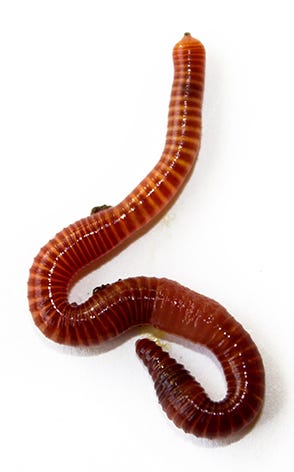Red wigglers: For organic gardening
Red wigglers: For organic gardening
Blog Article
Every Little Thing You Need to Know Concerning Red Wigglers for Composting
Red wigglers, or Eisenia fetida, play a pivotal duty in the realm of composting, changing organic waste into beneficial dirt changes. The procedure of establishing up a worm bin and keeping it can pose obstacles.
What Are Red Wigglers?

(eisenia fetida worms for sale)
Indigenous to North America, red wigglers are surface-dwelling organisms that choose wet, warm environments abundant in decaying organic matter. Their diet regimen consists mostly of decaying plant material, food scraps, and various other organic debris, which they consume and break down effectively. As they absorb this material, they generate nutrient-rich castings that improve dirt fertility.
Red wigglers are hermaphroditic, possessing both male and female reproductive organs, and can duplicate swiftly under optimum problems. Overall, red wigglers are vital contributors to the process of reusing organic waste into valuable garden compost.
Benefits of Making Use Of Red Wigglers
Utilizing red wigglers in composting systems provides countless advantages that enhance both the effectiveness of waste monitoring and the quality of the resulting compost. These worms, scientifically recognized as Eisenia fetida, are specifically efficient at damaging down raw material, transforming kitchen scraps and backyard waste into nutrient-rich compost at an accelerated price.
One of the primary benefits of using red wigglers is their ability to consume big quantities of organic product, frequently processing their weight in food waste daily. This high usage price leads to faster decomposition and lowers the quantity of waste sent out to garbage dumps. Additionally, the castings created by red wigglers are rich in necessary nutrients, advantageous microbes, and enzymes, making them an excellent fertilizer for yards and plants.
Additionally, red wigglers flourish in a selection of settings, making them versatile for both interior and outdoor composting systems - red wigglers. Their presence in a garden compost container aids to aerate the material, protecting against odors and advertising a healthy and balanced composting process. In general, utilizing red wigglers not only adds to reliable waste monitoring but likewise supports lasting horticulture techniques through the manufacturing of high-grade compost
(red worms near me)
Establishing Your Worm Bin
To successfully establish a worm bin, it is necessary to select an appropriate container that fulfills the needs of red wigglers while offering a helpful environment for composting. A suitable bin can be made from plastic, timber, or steel, with a capacity of a minimum of 1 square foot for every extra pound of worms.
Make certain the container has appropriate drain openings to protect against excess wetness, as red wigglers thrive in a wet, however not waterlogged, atmosphere. red wigglers. The container must likewise be ventilated to offer sufficient air flow, stopping anaerobic problems that could hurt the worms
A suitable area for the worm bin is a great, dark area, devoid of straight sunlight and extreme temperatures, as red wigglers prefer a temperature series of 55 to 77 degrees Fahrenheit.
Prior to introducing the worms, prepare bedding materials such as shredded paper, cardboard, or coconut coir, which will certainly provide both habitat and food. Dampen the bed linen lightly to produce a welcoming setting for the worms. Last but not least, think about putting a lid on the container to keep moisture and decrease parasites, while guaranteeing it can be easily removed for maintenance.
Feeding and Care Guidelines
Feeding red wigglers is a critical aspect of maintaining a healthy composting system. These worms flourish on a varied diet regimen, largely made up of natural products such as fruit and veggie scraps, coffee premises, and crushed eggshells. It is important to prevent feeding them meat, dairy, and oily foods, as these can create unpleasant smells and bring in pests.
When presenting food to your worm container, chop or shred materials into smaller pieces to help with quicker disintegration. Start with percentages to assess the worms' intake rate, slowly enhancing the amount as they adjust. It is advisable to alternative feeding areas within the container to urge thorough mixing and aeration of the garden compost.

Troubleshooting Common Issues
Maintaining a prospering worm composting system can occasionally offer difficulties that require focus and troubleshooting. Usual concerns include an unpleasant smell, which usually suggests overfeeding or the presence of anaerobic problems. To treat Learn More this, lower the quantity of food added and ensure correct aeration by blending the bed linen material.
An additional regular trouble is the getaway of worms from the container. This can happen due to too much wetness or inappropriate environmental problems. Regularly examine the dampness levels, aiming for a wet however not soggy consistency, and maintain optimal temperature levels in between 60-80 ° F(15-27 ° C )to create a comfortable environment for your red wigglers.
Pests, such as fruit flies, can likewise attack worm containers. red wigglers. To combat this, cover food scraps with a layer of bedding or shredded paper to deter flies from laying eggs. In addition, make certain that any food added is fresh and totally free from mold and mildew, which can bring in unwanted insects
Lastly, if your worms seem inactive, look for anxiety variables such as temperature variations or inadequate moisture. Attending to these common concerns will certainly help preserve a healthy and balanced and productive worm composting system.
Conclusion
In summary, red wigglers, or Eisenia fetida, play a vital role in sustainable waste monitoring via vermicomposting. Appropriate configuration and maintenance of a worm container, along with adherence to feeding guidelines, guarantee a thriving ecosystem that decreases landfill payments.
Report this page